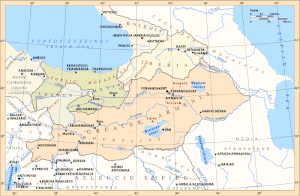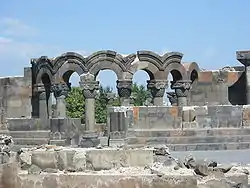Єрвандіди
Оронтіди, також Єрвандіди та Єрвандуні (вірм. Երվանդունիների հարստություն) (бл. 570 або 520 — 200 до н. е.) — вірменська династія іранського походження[1] [2] [3][4], що правила Вірменією в V — IV століттях до н. е., як перські (ахеменідські) сатрапи Східної Вірменії, в 323 — 200 р. до н. е. як незалежні царі Айраратського царства[5][6]. Згідно зі Страбоном («Географія», XI, 14, 15), походила від перського вельможі Гідарна, одного з семи вбивць Гаумата. Її відгалуженням вважається також династія Арташесидів, що правила Вірменією в II — I ст. до н. е. Згодом також правила в елліністичному царстві Коммагена.

Держава Єрвандидів
Примітки
- Encyclopedia Iranica. Tigran II.: "Tigran (Tigranes) II was the most distinguished member of the so-called Artašēsid/Artaxiad dynasty, which has now been identified as a branch of the earlier Eruandid dynasty of Iranian origin attested as ruling in Armenia from at least the 5th century B.C.E."
- David M. Lang. Iran, Armenia and Georgia // Ehsan Yar-Shater. The Cambridge History of Iran, Volume 3: The Seleucid, Parthian and Sasanid Periods, 1983б ISBN 052120092X. Стр. 494. "During the Seleucid period, Armenia became divided into several virtually independent kingdoms and principalities. The classification adopted at this epoch persisted, with certain changes, well into the Byzantine era.1 The most important region, of course, was Greater Armenia, situated east of the upper Euphrates, and including vast areas all round Lake Van, along the Araxes valley, and northwards to take in Lake Sevan, the Karabagh, and even the southern marches of Georgia. Lesser Armenia, on the other hand, was a smaller and less fertile kingdom, to the west of the upper Euphrates; it included the present-day districts of Slvas and Erzinjan, and bordered on ancient Cappadocia. To the south-west lay the two little kingdoms of Sophene and Comma-gene, separated from one another by the middle Euphrates, and having the fertile and desirable Melitene (Malatya) plain running between them. Sophene and Commagene often featured as buffer states between Par-thia and Armenia on the one hand, and Syria and Rome on the other. Their royal houses had strong dynastic links with the Armenian Oron-tid house. Through their proximity to such great cities as Antioch and Palmyra, the kingdoms of Sophene and Commagene early became great centres of Hellenistic and then of Roman art and civilization, which they in turn helped to transmit eastwards into Greater Armenia and Transcaucasia."
Стр. 535 "The most striking example of the syncretism of gods in ancient Parthia actually occurs in a former Armenian satellite kingdom, namely Commagene, the modern Malatya district. Here a scion of the Armenian Orontid house, King Antiochus I (69-34 B.C.) built himself a funeral hill at Nimrud Dagh (pis 37, 38). The sanctuary is grandiose, being surrounded on three sides by terraces and dominated by an artificial mound nearly five hundred feet high. On the east and west terraces stood a row of five colossal seated figures, many times life-size, which represented four deities and King Antiochus himself. The chief statue represents the compound deity Zeus-Oromasdes, or Ahuramazda. A second depicts Apollo-Mithra-Helios-Hermes. And a third presents to us Verethragna-Heracles-Ares. Into the terrace walls were sunk some ninety stone reliefs, depicting in most cases a pair of figures, one of whom is usually Antiochus. We see the king's paternal ancestors, traced back to the Achaemenian monarch Darius, son of Hystaspes, while Greek inscriptions record the dead ruler's connections with the Armenian dynasty of the Orontids." - Thomas T. Allsen. University of Pennsylvania Press, 2006. ISBN 0-8122-3926-1, 9780812239263. Стр. 37 "The Orontid dynasty of Armenia (ca. 401-200), whose ruling house was of Achaemenid origin". Стр.535 "The most striking example of the syncretism of gods in ancient Parthia actually occurs in a former Armenian satellite kingdom, namely Commagene, the modern Malatya district. Here a scion of the Armenian Orontid house, King Antiochus I (69-34 B.C.) built himself a funeral hill at Nimrud Dagh (pis 37, 38). The sanctuary is grandiose, being surrounded on three sides by terraces and dominated by an artificial mound nearly five hundred feet high. On the east and west terraces stood a row of five colossal seated figures, many times life-size, which represented four deities and King Antiochus himself. The chief statue represents the compound deity Zeus-Oromasdes, or Ahuramazda. A second depicts Apollo-Mithra-Helios-Hermes. And a third presents to us Verethragna-Heracles-Ares. Into the terrace walls were sunk some ninety stone reliefs, depicting in most cases a pair of figures, one of whom is usually Antiochus. We see the king's paternal ancestors, traced back to the Achaemenian monarch Darius, son of Hystaspes, while Greek inscriptions record the dead ruler's connections with the Armenian dynasty of the Orontids."
- T.B. Krause, J.A.C. Greppin, J. Slocum. Linguistics Research Center at University of Texas, USA. The Yervanduni Dynasty.: "Yervanduni is the name given to a family whose members were appointed by the Medes and Persians as governors in Armenia over the period 585 - 200 B.C. At least four of these governors were named Yervand. Their ethnic background is not clear. Most now believe the Urartuan and Armenian ethnicities to have been distinct, and it is not certain from which culture the Yervandunis originated. The Yervandunis were related somehow to the Persians, if not by blood, at least through bonds of marriage."
- ВРЕ Вірменська РСР V. Історичний нарис
- Всесвітня історія, М., 1956, т. 2, стор. 418
This article is issued from Wikipedia. The text is licensed under Creative Commons - Attribution - Sharealike. Additional terms may apply for the media files.
